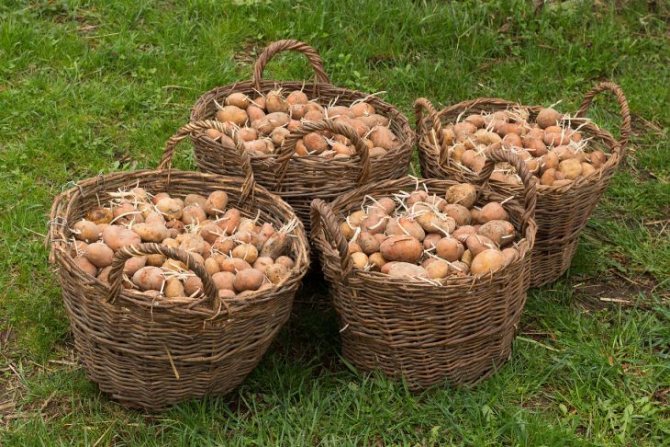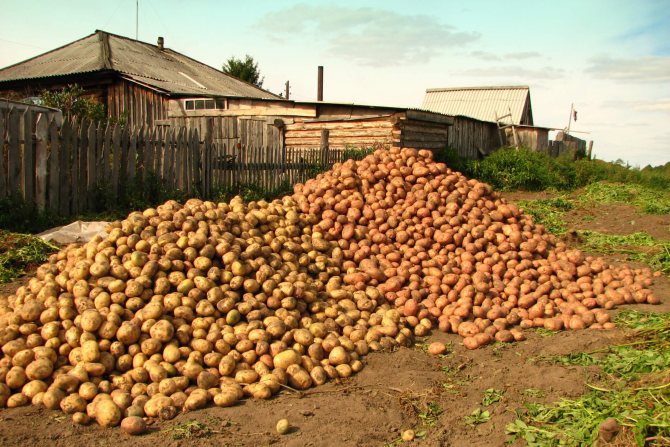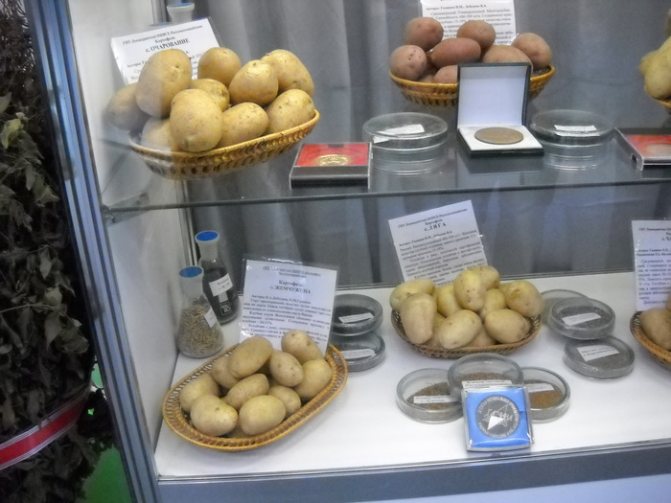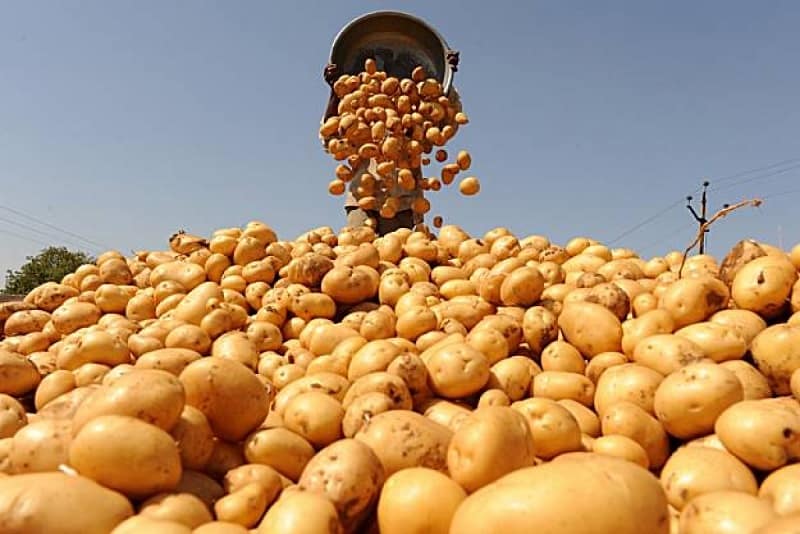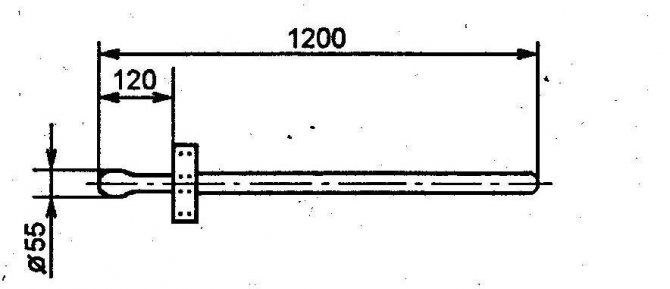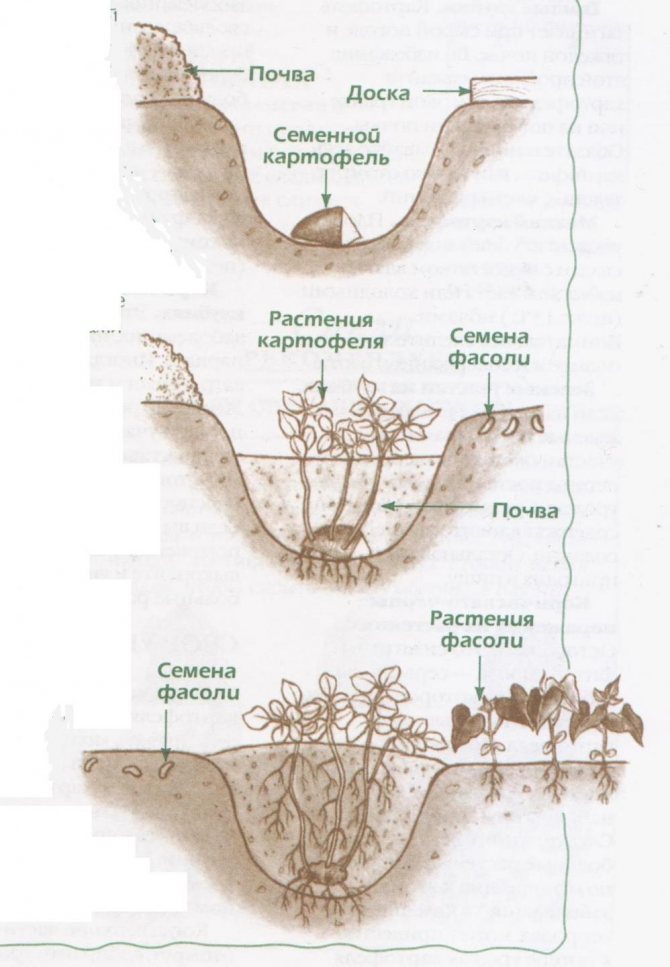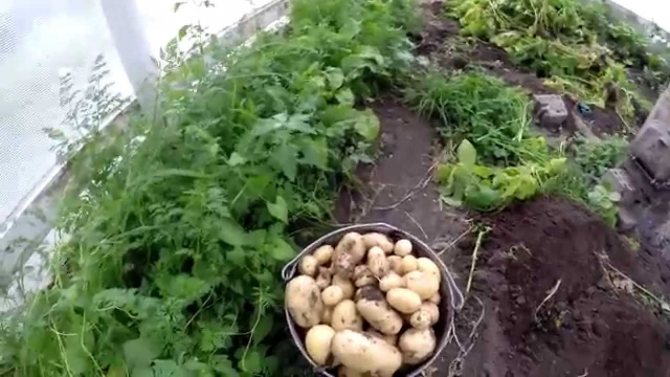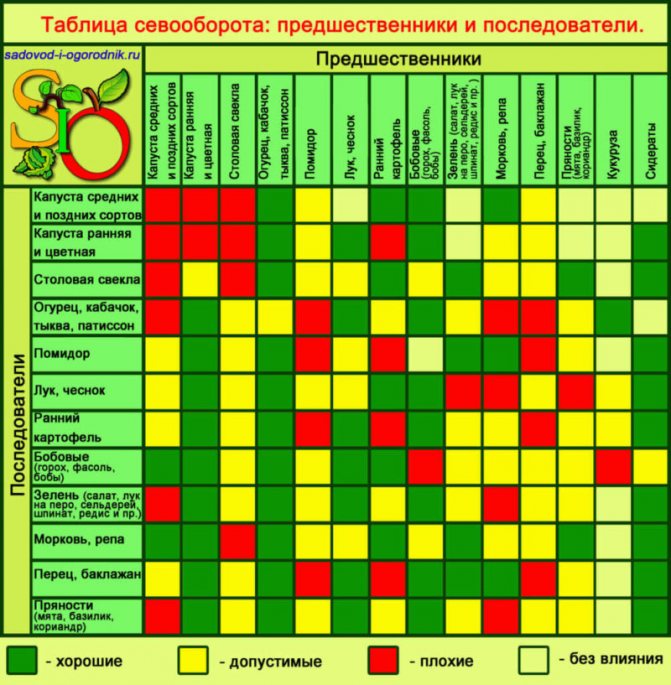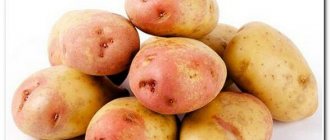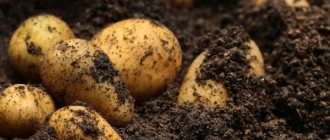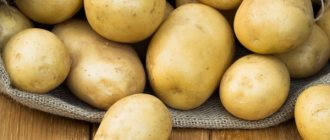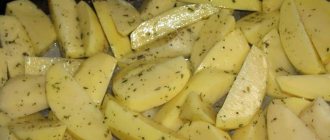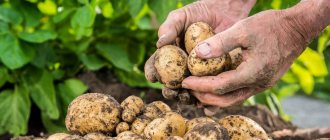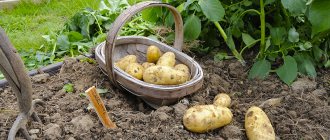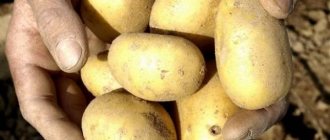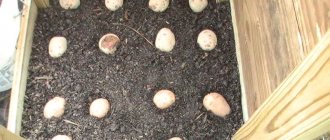Most farmers, when planting potatoes, choose the method of planting tubers, but this is far from the only way to get a healthy harvest. In addition, planting in the ground - can be effectively replaced with planted potatoes in a bag. It is important to clarify that the usual, potato planting periods can be changed!
Potatoes are a traditional vegetable crop in Russia. Everyone knows how it is cultivated. Therefore, it is thankless to give classic recommendations on potato farming. Let's talk better about non-traditional: methods of growing a popular root crop.
To my surprise, I received many letters with extremely interesting suggestions. Someone plants potatoes in boxes so as not to huddle and protect them from the Colorado potato beetle. Someone buries in old tights when landing in the ground, so that it is easier to collect in the fall. How do you like “potatoes under a straw fur coat”? Truly, the Russian land is strong with its folk ingenuity! Of course, not everything proposed to me seemed rational. But I took note of some ideas and even tested them on my own experience. I'll tell you how you can diversify the methods of growing potatoes in order to get the first harvest in June!
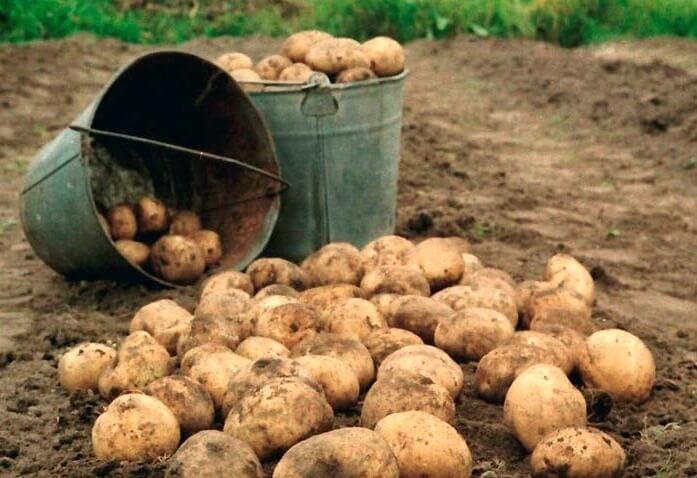
Site preparation
Root vegetables have long been a favorite dish on the table of compatriots, so any free space is given to popular culture. The potato is a light-loving plant that needs a lot of sun. The more trees and fences nearby, the less tasty the product.
Anastasia Lipatova proposes to break the beds in the direction from north to south. Like strawberries, the luminary will evenly illuminate the potatoes throughout the day. Until noon, the rays will touch the eastern side of the grooves, and after 12 noon - the western side. Thanks to this trick, plantings receive maximum heat and energy, which significantly increases yields.
If it is not possible to organize the correct crop rotation, then the fertility of the site can be restored with the help of green manure. After the vegetables have been harvested, you cannot leave empty land. In August or early September, the place is sown with watercress, rye or mustard. In the second half of October, the plants are mowed, and the soil is dug to a depth of at least 18 cm. In this simple way, the soil is enriched with nutrients and disinfected.
By the way, compost beds will be relevant for small land plots. After the crop is harvested, good plant residues are harvested on the site that is planned for growing potatoes. The earth is carefully dug up together with greens and branches, leaving it until spring. By the beginning of the new growing season, the soil becomes the most nutritious for the culture.
Average yield
The yield of potatoes from 1 are different in different regions: it all depends on the climate and soil fertility. So, in the Voronezh region 150 kg are harvested from a hundred, in Kursk - 200 kg, Penza - 120 kg, Samara and Ulyanovsk - 250 kg, and in Tatarstan - 160 kg. Siberians also manage to harvest potatoes, planting early and early varieties, which by the end of the short summer yield 200-300 kg per hundred square meters. In the Urals, the yield is lower and is 120-170 kg per hundred square meters.
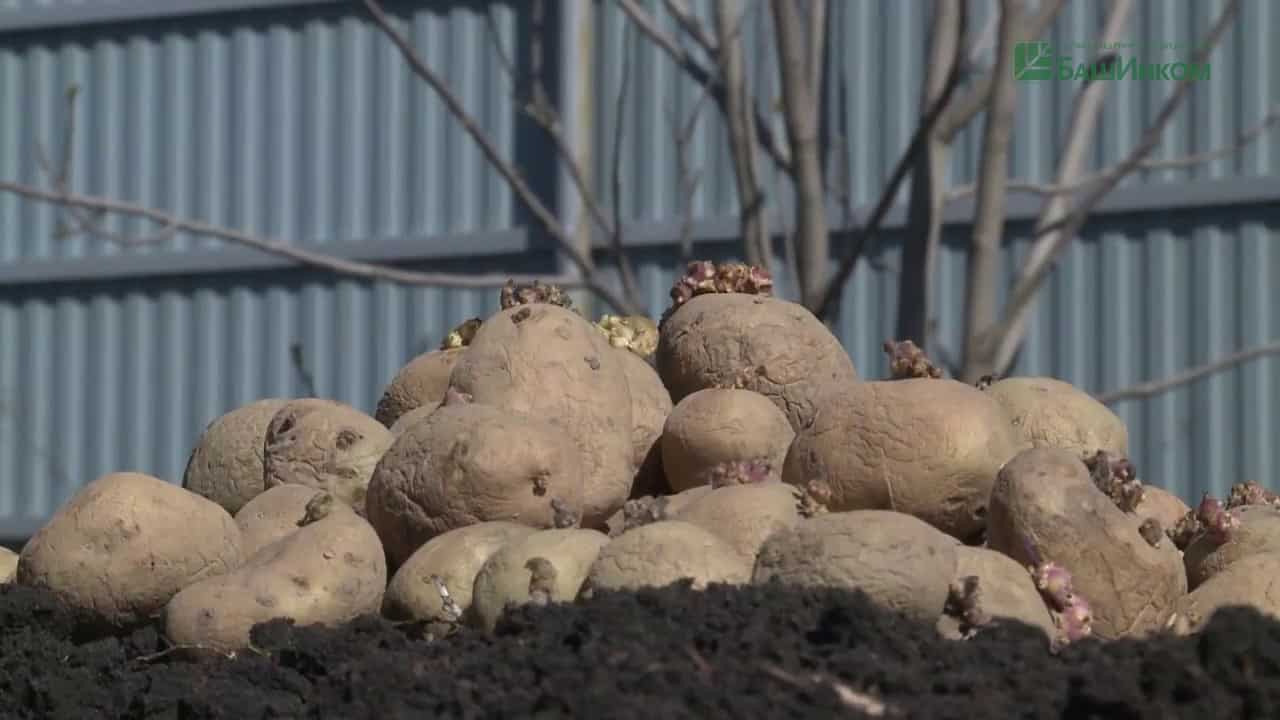

If we average these indicators, it turns out that on the territory of Russia the yield of potatoes per hundred square meters is about 150 kg. Many gardeners who allocate a part of the land on the plot for cultivation prefer not to consider kilograms, but to their usual "buckets": good resistant varieties give 5 buckets of harvest from 1 bucket of planting material.
Variety selection
Increasing the yield of a small plot is difficult without high-quality hybrids. For several years, summer residents can use their favorite variety of root crops. Gradually, such a plant degenerates - the taste characteristics deteriorate, therefore, an update of the "model range" is required.
- Among the most inexpensive, but prolific varieties, it is worth noting the Bulletin - a mid-season universal potato that will delight you with disease resistance and give the owner a rich harvest.
- Seeds Lux and Mayak grow well on low-nutrient lands, they are not capricious to care. Excellent taste and good feedback will appeal to novice farmers.
- Among the elite varieties, Bellarosa is considered the favorite, grown in all countries of Eastern Europe. If the minimum breeding requirements are met, farmers receive 3.5 quintals from one hundred square meters. Beautiful oval tubers ripen early, so in the southern regions they harvest twice a season.
- The German variety Adretta is excellent for natural farming with a minimum of chemical additives. The most undemanding hybrid develops on both clay and sandy soils. Resistant to drought and moisture, it quickly forms good tubers - up to 140 g.
Additional actions
Perhaps not all farmers know the distribution of active substances in plant organs.
Visually, everyone observed the beauty of the flowering of the potato bush, namely, the flowers deprive the plants of their harvest, since about 30% of the nutrients are spent on them.
This is because the flowering of the bush and the formation of tubers begins at the same time, therefore, the involuntary theft of the necessary food takes place.
Experienced business executives carry out the removal of peduncles during the budding period, providing these actions with an outflow of organic matter for the fruits, allowing them to pour on a large scale.
Preliminary processing
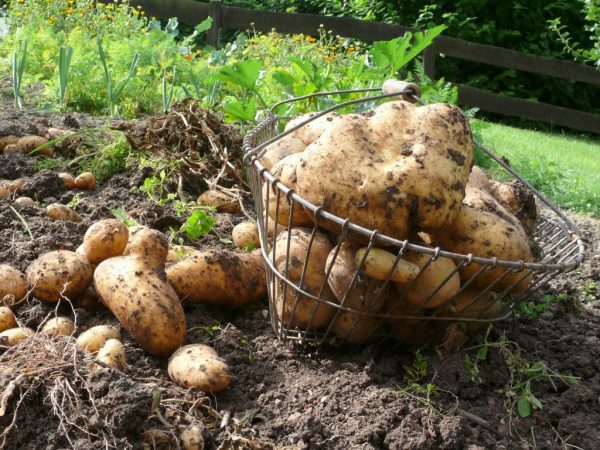

Large potatoes in pre-processing
The maximum yield of plants depends on the quality of the seeds and the pre-treatment. If there are no funds to purchase a super-elite hybrid, we recommend thoroughly disinfecting the tubers. There are several options for solutions.
- Natural. Add one kilogram of crushed garlic to a bucket of water. Raw materials are kept in moisture for at least three hours.
- Classical. Copper sulfate is mixed in 10 liters of liquid with boric acid and potassium permanganate. Substances not only kill pathogenic bacteria, but also activate metabolic processes.
- Nutritious. Urea and superphosphate are added to the classic recipe. This solution destroys fungi, while "feeding" the tubers.
- For aerosols. Potassium sulfate is mixed with urea vitriol, manganese and boric acid. Substances are dissolved in water, filtered and used for air treatment.
Bathing in special solutions is a must for root crops. It is impossible to get a good harvest without copper-based chemicals. In domestic climatic conditions, late blight spreads at the earliest opportunity. In the affected areas, not only potatoes die, but also all subsequent plants.
The concept of biostimulants
The addition of biostimulants, natural or synthetic compounds to the wells, significantly increases growth, develops a root crop. Biostimulants affect the rate of metabolism of nutrients, potatoes begin to grow, increasing the number and size of vegetables. The use of Gibbersib vegetable growers in the world is a good example.
The evidence is the following characteristic data:
- acceleration in the growth and development of vegetables
- raising the ovaries on the peduncle
- shortening the period of fruit filling
- protection against diseases
Epin extra
The drug is supposed to be used in a diluted form, instructions are provided on the packaging.
The solution is used to treat potatoes before sowing them in the field.
There is official evidence that such processing can increase fertility up to 35%.
Many people know the names of Epin and Silka - they were created with the aim of achieving a kind of protein stress in plant organisms, creating a protective immune system against pathogenic bacteria.
With the help of a similar phytohormone effect, the intake of a beneficial substance into the fetus is regulated during its growing season.
Many useful properties in vegetables have been registered by scientists in their studies, after the use of these substances, the important of which are highlighted:
- vegetable growth is accelerating
- ripeness is faster
- the composition of starch increases
- the amount of fiber increases
The use is quite simple, it is enough to spray it with a solution 2 times and the potatoes will take on all the positive qualities acquired from phytohormones.
How to increase fertility
On a small garden plot, it is difficult to improve the quality indicators of the variety. If you are looking for a way to increase the yield of your potatoes, then it is worth trying the proven method laid out on Lipatova Canal. The increase from each bush can reach more than ten percent.
To stimulate the shoots, the tuber is cut along the entire circumference to a depth. With this option, nutrients are redirected to the lateral buds, which accelerates germination. This root crop has a larger number of stalks, which will increase the volume of production from the bush.
The transverse annular cut activates the lower dormant eyes, and the longitudinal - the upper ones. If you hold the "operated" seed at a temperature of 15 to 18 degrees for a month, the efficiency of forcing will improve. This option is easy to do in an apartment. By the way, in order to prevent infection from getting into the wounds, the tubers are disinfected in potassium permanganate.
How to plant
A good harvest of homemade potatoes is a correctly chosen planting scheme. Summer residents are limited in usable area, so you have to place root crops in a small area where there is a free piece. The growth of the crop is influenced by the width between the rows, which should be at least 70 cm. In a narrower space, the plants lag behind in development.
If there is not enough space, then the seeds can be grown in vertical beds. A "tower" is assembled from the mesh, which is filled with layers of straw and nutrient soil. For tiny areas, we recommend experimenting with “mobile” structures such as barrels or shopping bags.
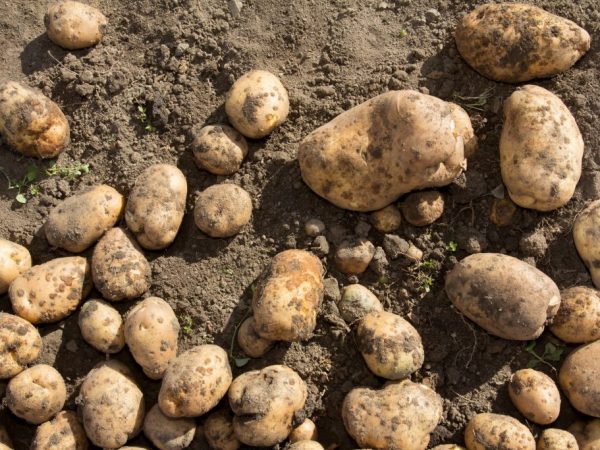

We seat in the holes
The easiest and most reliable planting method is the Dutch ridge method. Plants are provided with good air circulation, as a result of which they grow strong and healthy. The "shovel" technology familiar to the domestic farmer is still relevant, but you should not bury the tubers deeper than 10 cm, otherwise the potatoes will grow small.
Watering
No matter what summer residents say, proper watering always affects the yield of potatoes. Crops, where an important procedure takes place exclusively at the whim of nature, it is difficult to achieve maximum return. The fact is that life-giving moisture is required at different stages of the development of culture.
- After the sprouts appear. Water activates metabolic processes and helps the plant grow good roots and tops. Even a small deficit during this period will negatively affect the general condition and immunity of the potato.
- Before flowering. As soon as buds appear, irrigation must be carried out immediately.Lack of moisture will cause the plant to shed its ovaries.
- Fruit formation. The final step helps the crop grow in tuber size.
“Disturbances in air circulation and moisture movement will lead to the multiplication of harmful
bacteria and insects. "
To increase the yield of home potatoes, it is important to pour at least three liters of liquid under each bush. If the summer is wet, then you should not be zealous with watering, otherwise the root crops will begin to rot. Irrigation is carried out at the root or along the furrows in the evening or early morning. Daytime treatments can cause burns. Remember that excess water in the last weeks before harvesting will impair keeping quality.
Fertilizers
The original method of obtaining a record crop of potatoes in a small garden requires carefully selected nutrients from the owners. Natural farming, which Anastasia Lipatova offers, practically excludes chemical additives. Vermicompost contains all elements important for plants - nitrogen, potassium and phosphorus. A deficiency of one of the substances will always affect the quality and quantity of root crops.
The first application is carried out during the period of active growth, especially with weak, lifeless stems. Early feeding allows you to achieve good results in adding fruit. For ten meters of a potato bed, we recommend using 5 tablespoons of urea and 14 glasses of humus. By the way, an excess of organic matter can provoke the onset of diseases.
The second stage affects the intensity of flowering, therefore it is carried out during budding. A glass of ash and 50 g of potassium sulfate can be used as food sources. Substances are added to a bucket of water, after which the beds are watered.
The latter fertilizer speeds up the formation of tubers, so you should not abandon the procedure. During this period, nitrogen preparations are contraindicated, otherwise the plant will redirect forces to the formation of greenery. Now it is allowed to use superphosphate and nitrophosphate both under the root and on the leaf.
Hilling
Among the proven secrets of improving yields, not the least is the "rolling" of seeds with mounds of earth. Novice farmers often do not understand the meaning of the procedure, so they try not to use a strange method because of the banal “I don’t want to waste time”. If you have not used alternative planting methods, then you should not deprive the potatoes of the necessary development conditions.
Hilling bushes, farmers not only loosen the soil and destroy weeds. Thanks to the measures, the plant improves the air exchange of the roots and the illumination of the tops. The lower parts of the potatoes begin to actively form stolons, on which tubers will soon appear. The procedure is best done twice - after the leaves have opened and three weeks later.
The main factors of high yields
Every farmer will not be him if he does not dream that the yield of his potatoes from 1 hundred square meters reaches a value that is the envy of his colleagues. To get a decent result from your hard work, you need to create the following conditions:
- increase the fertility of the land
- select a high-quality composition of the seed fund
- observe agrotechnical rules in storage, preparation of seeds for storage and planting them in the ground
- carry out planting work correctly and on time, taking into account the dependence on the region, soil, weather conditions
Every season, gardening work is carried out, vegetable seeds are planted, and the harvest is harvested. The land from such actions is depleted from oversaturation with chemicals aimed at fertilizing it or fighting plant pests. There are ways to restore health to the soil, this will increase the yield of vegetables grown on the site.
It will return the ability to fertile the site well if you add:
- 6 kg. for 1 sq. m. environmentally friendly natural fertilizer called compost
- sprinkle the surface with ash at the rate of 1 glass per 1 sq. m.
Gardeners, after harvesting the fruits, immediately think how to save them, select the best specimens for the next planting.
The potatoes are sorted out, discarded in a separate container:
- seeds are not less than a chicken egg in size
- whole
- no signs of bacterial plaque
- divided into varieties
- washed and discarded
How to increase fruit size
Among the secrets that help to get a big harvest in a small garden is the old method, described in detail by Anastasia Lipatova. After the plants bloom, you should wait two to three weeks. After the expiration of the term, the stems are broken at a height of up to 15 cm from the ground. It is important that the bush does not lose its integrity.
The nutrients in the tops reach the breakdown and return to the roots. The stems do not wither, so photosynthesis is not disturbed. The vital activity of the potato continues: the size of the tubers increases, and the greens cease to pull important components onto themselves.
By the way, the technique is effective only for healthy bushes. A potato stricken with ailment and insects will not have enough strength to "reorient". Sick specimens often shed their foliage and wither.
Cultivating potatoes in a small garden can yield excellent returns from any variety. Knowing how to get a good harvest on your own, it is easy to see all the strengths and weaknesses of the site. The recommendations provide secrets to help you achieve great results.
Planting rate and potato consumption per 1 ha
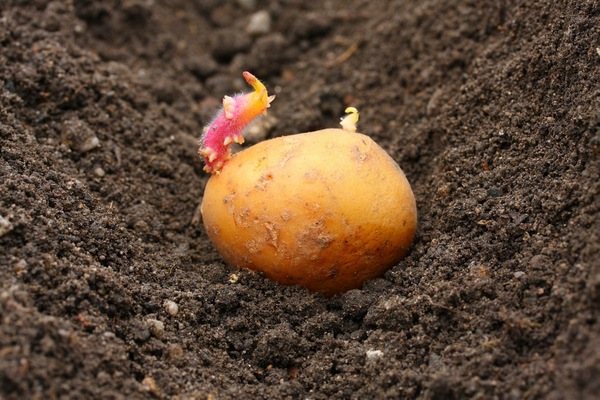

In the traditional way, potatoes are planted in furrows. The width of each of them can be in the range from 70 to 90 cm.The optimal distance between root crops should be from 25 to 45 cm.
The amount of seed material required is determined by calculation for each specific site. As a sample, you can use an example of calculation for 1 hundred square meters (a field of 10 * 10m):
- set the approximate distance between the rows (in our case, it is 70 cm);
- we determine the number of furrows that will fit on the field (taking into account the indentation, it will turn out to be 14 pieces);
- determine the required distance between tubers (we will take 40 cm as a sample);
- by calculation, we determine the number of potatoes that should be planted in one row (25 pieces are obtained);
- multiply the numbers obtained (350 potatoes come out);
- the average mass of a tuber for planting is 75 g, so about 26 kg of seed is needed for a plot of one hundred square meters.
On a note! In practice, when preparing seeds, it is also necessary to take into account various errors. For example, some of the tubers may deteriorate during the winter, the mass of potatoes may differ from the average in one direction or another. For reliability, it is necessary to prepare about 28-29 kg of planting material.
In the same way, the amount required for planting potatoes and for a plot of 1 hectare is calculated. A similar calculation shows that about 2.8-2.9 tons of seed will be required.
In any case, it is recommended to carry out all calculations with your own hands, taking into account not only the size of the site, but also the size of the seed potatoes, as well as the distance between the furrows and the finished bushes.
Secret 6: a nutritious menu
In order for the potatoes to feed us all winter and spring, we must also give him three meals a day at least once a year - feed him "breakfast, lunch and dinner."
Potatoes Here is one of the options for such a three-time feeding for the whole season:
I feeding
Most effective during the active growing season, especially if the stems are weak and thin. Experienced summer residents advise using green fertilizer - it will well support the active growth of the stems. You can use the following tried and tested recipe:
- Recipe
Influence of humates on the yield
The intensity of agricultural production assumes getting the maximum yield from the selected crops while minimizing the cost of material resources and preserving the useful qualities of the product. These properties are possessed by humates, powerful activators for increasing the growth of the body, protecting the plant from the adverse effects of pathogenic bacteria. They create special enzymes in vegetables that make it possible to overcome adverse conditions. The drug has been tested on large potato fields, resulting in a yield increase of 35%.
Humic preparations are used by the following methods:
- The planting material is soaked in the prepared substance. This can be done when the tubers are being prepared for germination and before planting. You just need to pour the mixture over the seeds and leave for 10 hours. After the potatoes are taken out of the solution, it is poured into the holes. When shoots appear, hilling begins and the bushes fall asleep, then all the useful properties of the product will be directed to the root system, but not to the growth of the tops.
- There is a special powder preparation that can be used to sprinkle the tubers before placing them in the ground. It is able to stick to the fruit without crumbling from the surface of the potato.
At the initial moment, the substance is able to provide the vegetable with nutrients, protects against the following unseemly formations:
- late blight
- scab prominent
- sulfur
- putrid
Root crops are protected from such diseases at the time of storage for winter storage. In any case, no matter how the substance is used, the fruits are soaked or sprinkled during the growing season, during the formation of buds before flowering, you need to understand that the use of humates is not a substitute for fertilizers, they can enhance the action of mineral and organic substances.
Potato growers should take into account that only the correct use of agricultural technology can increase yields in conjunction with the rules of technological processes.
The video shows a method of planting potatoes for an excellent harvest:
Have you noticed a mistake? Select it and press Ctrl + Enter to tell us.
Quality planting material
To get a high yield of potatoes, it is important to choose the right seeds. Potatoes can grow in one place for many years, but over time they degenerate, and the yield decreases. When choosing a variety, pay attention to the fact that there are early, medium and late varieties. The optimal planting is considered to be 40% early, 35% medium and 25% late varieties.
The issues of growing potatoes will always worry summer residents. And over time, they will surely reveal all the secrets of this culture and will be able to get a bountiful harvest. Do not stay away from the search and share your thoughts on our forum.
Correct fit
When potatoes are planted in ridges, the yield is 2 times greater than with traditional planting. In order not to scatter fertilizers over all surfaces and not to provoke the appearance of weeds, humus and mineral fertilizers should be applied under each tuber. Nutrition for the tuber consists of a handful of humus, as well as 1 tbsp. l. ash and complex fertilizers. The planting depth of potatoes is 12-15 cm. The optimal planting density is 350-400 bushes per one hundred square meters. Based on this, it is necessary to correctly determine the width of the row spacing and the distance between the tubers. However, it is impractical to do less than 0.5 m between the rows.
Do not thicken the planting, all the bushes should have enough light and warmth
Care during the entire growing period
When caring for potatoes, it is important to keep the soil in the aisles and around the bushes clean and loose. Potato seedlings can be fed with nitrogen fertilizers. They stimulate plant growth and inhibit weed growth. In dry periods, limit the amount and depth of loosening, and in excessively wet periods, on the contrary, it is advisable to loosen the soil more often.The greatest harm to potatoes is brought by late blight and the Colorado potato beetle. Therefore, it is important to protect plants from these diseases and pests by correctly processing them.
If all else fails
If all the recommendations described above do not help or do not suit you in some way, tiny potatoes prevail in a small crop, and the question of how you can increase the yield of potatoes on a personal plot is still on the agenda. it is worth taking a closer look at individual techniques:
- Gülich's method consists in dividing the garden into squares with an area of 1 × 1 m2. The soil in the center of each conventional cell must undergo a mulching and composting procedure. The planting material is placed in a square with the sprout down and sprinkled with earth on top;
- The Meatlider method is staggered potatoes. The rows should be spaced one meter apart, and the gap between the holes is 45 centimeters;
- According to Dutch technology, seed is placed in high beds (their width is 45 centimeters) with fertilizer. The distance between them is about 80 centimeters. Care is usual: mulching, watering and feeding.
Trying to increase the yield of potatoes, you cannot limit yourself to only one method or method. Experiments should be performed on a small amount of planting material. Their results will show what needs to be changed in the usual cultivation technology for the next year.
Sources:
Which potatoes to plant?
Unfortunately, there is no universal answer to this question. Different varieties of potatoes are suitable for different territories, and you need to plant those that give a decent harvest on a particular land. For the first time, you need to take several types of potatoes (you can first consult with neighbors in the area who have already harvested).
For planting, you need to choose at least two, and preferably three or four potato varieties. At the same time, it is necessary to pay attention to the period of potato ripening - for storage "in winter", later ripening varieties are selected, for food - early ones.
How to choose material for landing?
You need to take care of picking up potatoes for spring planting in the fall, when harvesting. You need to choose the potatoes that have shown good results on the ground. In planting choose dense, medium-sized potatoes of the correct shape, without "eyes", deformation and other damage.
The planting tubers are kept in the light for several days so that they acquire a green tint, and then they are removed in a separate box in a cool, dark place. At the end of winter, the tubers begin to germinate. Many people plant potatoes by simply throwing the tubers into the furrow - this approach does not guarantee a rich harvest. To improve yield indicators, you need to prepare planting material.
Potato seed prices
How to cook potatoes for planting?
Tubers selected in the fall must be transferred to boxes or plastic bags with holes made in them for perforation. It is necessary that the planting material is in a temperature of 12 to 15 degrees, and also receives a lot of sunlight. When the first green seedlings appear on the tubers, I place the potatoes in any volumetric container (boxes, baskets, containers) and sprinkle them with a moist substrate (peat, sawdust, earth).

